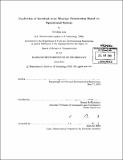| dc.contributor.advisor | Hamsa Balakrishnan. | en_US |
| dc.contributor.author | Lin, Yi-Hsin, S.M. Massachusetts Institute of Technology | en_US |
| dc.contributor.other | Massachusetts Institute of Technology. Department of Civil and Environmental Engineering. | en_US |
| dc.date.accessioned | 2013-12-06T20:48:04Z | |
| dc.date.available | 2013-12-06T20:48:04Z | |
| dc.date.issued | 2013 | en_US |
| dc.identifier.uri | http://hdl.handle.net/1721.1/82840 | |
| dc.description | Thesis (S.M. in Transportation)--Massachusetts Institute of Technology, Department of Civil and Environmental Engineering, 2013. | en_US |
| dc.description | Cataloged from PDF version of thesis. | en_US |
| dc.description | Includes bibliographical references (pages 89). | en_US |
| dc.description.abstract | As demand for air transportation grows, the existing air traffic control system is being pushed to capacity. This is especially true during weather events. However, the degree to which weather impacts airspace capacity, particularly within the terminal region, is not well understood. Understanding how weather impacts terminal area capacity will be important for quantifying the uncertainty inherent in weather forecasting and developing an optimal mitigation strategy. In this thesis, we identify and analyze operational features that may impact whether a pilot chooses to fly through severe weather. In doing so we build upon the work done at MIT Lincoln Laboratory on terminal area Weather Avoidance Fields (WAF) for arriving aircraft. This model predicts the probability of pilot deviation around weather, based solely on weather features. The terminal area WAF was calibrated based on historical pilot behavior during weather encounters near the destination airport. Our model extends the WAF by incorporating operational factors such as prior delays and existing congestion in the terminal airspace. Instead of predicting the probability of deviation, our model will predict the maximum WAF level penetrated by the pilot, using the operational features as input. The thesis combines predictive modeling with case studies to identify relevant features and determine their predictive skill. An understanding of how operational factors impact weather avoidance will allow researchers to better quantify weather forecasting uncertainty and to understand when precision in forecasting is important. In turn, this will improve our ability to find optimal strategies for delay mitigation. | en_US |
| dc.description.statementofresponsibility | by Yi-Hsin Lin. | en_US |
| dc.format.extent | 89 pages | en_US |
| dc.language.iso | eng | en_US |
| dc.publisher | Massachusetts Institute of Technology | en_US |
| dc.rights | M.I.T. theses are protected by
copyright. They may be viewed from this source for any purpose, but
reproduction or distribution in any format is prohibited without written
permission. See provided URL for inquiries about permission. | en_US |
| dc.rights.uri | http://dspace.mit.edu/handle/1721.1/7582 | en_US |
| dc.subject | Civil and Environmental Engineering. | en_US |
| dc.title | Prediction of terminal-area weather penetration based on operational factors | en_US |
| dc.type | Thesis | en_US |
| dc.description.degree | S.M.in Transportation | en_US |
| dc.contributor.department | Massachusetts Institute of Technology. Department of Civil and Environmental Engineering | |
| dc.identifier.oclc | 863223656 | en_US |
